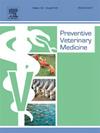Identifying critical control points for colostrum contamination in first milking colostrum from Scottish dairy herds
IF 2.2
2区 农林科学
Q1 VETERINARY SCIENCES
引用次数: 0
Abstract
Excessive bacterial contamination (≥100,000 colony forming units [CFU]/ml total bacteria count (TBC) and ≥ 10,000 CFU/ml total coliform count [TCC]) reduces the quality of colostrum and subsequent absorption of IgG across neonatal enterocytes, leading to failure to transfer of passive immunity (FTPI). Furthermore, the presence of pathogenic bacteria can cause disease in their own right. The objectives of the study were to identify critical control points and farm risk factors to minimise colostrum contamination from Scottish dairy herds. Eleven farms in Dumfries and Galloway, Scotland, were enrolled and first milking colostrum was sampled at sequential control points throughout the harvest, storage and feeding process. Farmers also completed a questionnaire at enrolment detailing colostrum management practices to identify risk factors for high bacterial contamination. Samples then underwent testing to estimate TBC, TCC and Brix % (measure of total solids estimating IgG concentration). Samples collected directly from cows’ teats had a lower median TBC (4000 CFU/ml, IQR = 15,000 CFU/ml) and TCC (1850, CFU/ml, IQR = 3775 CFU/ml) than those collected from storage buckets (median TBC = 101,000 CFU/ml, IQR = 930,000 CFU/ml and median TCC = 12,000, IQR = 108,000 CFU/ml) and feeding equipment (median TBC = 410,000 CFU/ml, IQR 3230,000 CFU/ml; median TCC = 40,000, IQR = 375,000 CFU/ml). Linear regression models revealed higher bacterial contamination was associated with a larger number of buckets used between harvest and storage of colostrum; smaller size of containers used to store colostrum, method of colostrum storage (freezing), and method of teat cleaning (wet wipe). Mean teat, storage bucket and feeder Brix (%) values were 23.1 %, 22 % and 23.1 % respectively. A one-way repeated ANOVA showed no difference in Brix % between source type (F = 2(3168), p = 0.1). Brix % was negatively associated with increasing time from calving to colostrum harvest.
确定苏格兰奶牛场初挤奶初乳污染的关键控制点。
过多的细菌污染(≥100,000菌落形成单位[CFU]/ml总细菌计数(TBC)和≥ 10,000 CFU/ml总大肠菌群计数[TCC])会降低初乳质量和随后新生儿肠细胞对IgG的吸收,导致被动免疫转移(FTPI)失败。此外,致病细菌的存在本身也会引起疾病。该研究的目的是确定关键控制点和农场风险因素,以尽量减少苏格兰奶牛群的初乳污染。在苏格兰邓弗里斯和加洛韦的11个农场进行了登记,并在整个收获、储存和喂养过程的顺序控制点取样了第一次挤奶初乳。农民还在登记时完成了一份调查问卷,详细说明了初乳管理方法,以确定高细菌污染的危险因素。然后对样品进行检测,以估计TBC, TCC和Brix %(估计IgG浓度的总固体测量)。直接从奶牛乳头采集的TBC中位数(4000 CFU/ml, IQR = 15000 CFU/ml)和TCC中位数(1850,CFU/ml, IQR = 3775 CFU/ml)低于从储存桶(TBC中位数= 101,000 CFU/ml, IQR = 930,000 CFU/ml, TCC中位数= 12,000,IQR = 108,000 CFU/ml)和饲养设备(TBC中位数= 410,000 CFU/ml, IQR = 32300,000 CFU/ml)采集的TBC中位数(4000 CFU/ml, IQR = 15,000 CFU/ml);中位TCC = 40000, IQR = 375000 CFU/ml)。线性回归模型显示,较高的细菌污染与收获和储存初乳之间使用的桶数量较多有关;用于储存初乳的容器尺寸较小,初乳储存方法(冷冻)和清洗方法(湿擦)。平均奶头、贮桶和喂料器白锐度(%)分别为23.1% %、22. %和23.1% %。单因素重复方差分析显示不同来源类型Brix %无差异(F = 2(3168), p = 0.1)。Brix %与犊牛至初乳收获时间的增加呈负相关。
本文章由计算机程序翻译,如有差异,请以英文原文为准。
求助全文
约1分钟内获得全文
求助全文
来源期刊

Preventive veterinary medicine
农林科学-兽医学
CiteScore
5.60
自引率
7.70%
发文量
184
审稿时长
3 months
期刊介绍:
Preventive Veterinary Medicine is one of the leading international resources for scientific reports on animal health programs and preventive veterinary medicine. The journal follows the guidelines for standardizing and strengthening the reporting of biomedical research which are available from the CONSORT, MOOSE, PRISMA, REFLECT, STARD, and STROBE statements. The journal focuses on:
Epidemiology of health events relevant to domestic and wild animals;
Economic impacts of epidemic and endemic animal and zoonotic diseases;
Latest methods and approaches in veterinary epidemiology;
Disease and infection control or eradication measures;
The "One Health" concept and the relationships between veterinary medicine, human health, animal-production systems, and the environment;
Development of new techniques in surveillance systems and diagnosis;
Evaluation and control of diseases in animal populations.
 求助内容:
求助内容: 应助结果提醒方式:
应助结果提醒方式:


